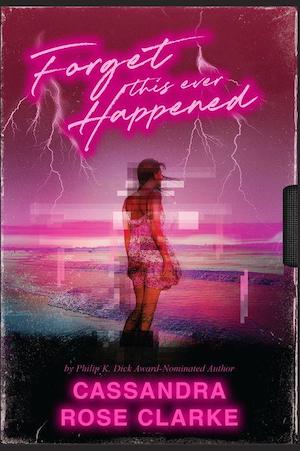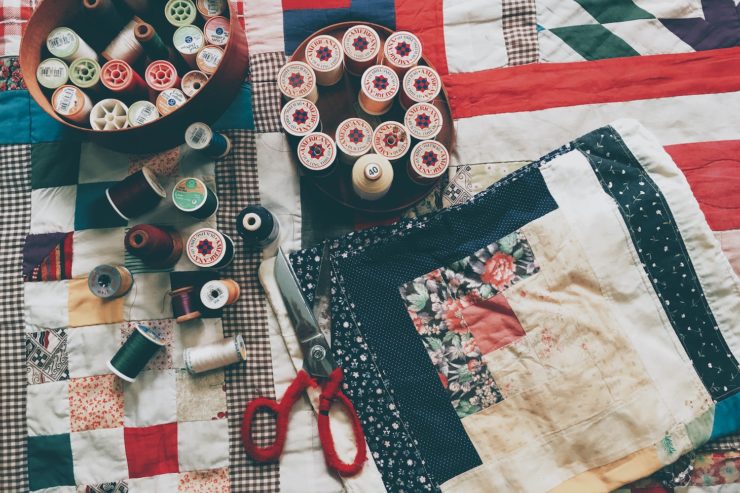Around the time that The Force Awakens was released, I found myself in my local Jo-Ann craft store. This particular Jo-Ann had thoughtfully set up a display with bolts of cotton printed with images of BB-8, Finn, Rey, Kylo Ren, the Star Wars logo, and so on. Like most of us, The Force Awakens had re-awakened my love of Star Wars, and I was ready to channel that love—not into fanfiction or cosplay or an impressive action figure collection, but into a quilt.
I love quilts. I made my first one when I was in elementary school, under my mom’s guidance, and I’ve made several in the years since. It’s not a consistent hobby—I’m not working on a quilt at the moment, for example—but it is one I always return to. Making a quilt is a lengthy process, but also a weirdly soothing one.
I always begin a quilt with fabric selection. What color and pattern combination do I want to use? Is there a particular fabric I want to draw attention to? With the Star Wars quilt, I used a combination of the Star Wars licensed fabric and regular quilting fabric in corresponding colors. I knew I didn’t want the entire thing to be Star Wars fabric, as that could wind up looking busy, and so I wound up choosing gray, orange, red, and white fabrics to complement the licensed fabrics. The white fabric was my favorite, as it was actually shot through with shimmery thread that reminded me of stormtrooper armor and the feel of ‘70s sci-fi movies generally.
Quilts are often divided into two broad categories: modern and traditional. Traditional quilts are what most people think of when they hear the word “quilt”: lots of small scraps of different, usually patterned, fabric pieced together into a design block with a name like log cabin or flying geese. Then these design blocks are sewn together. Modern quilts, on the other hand, are much more free form. They won’t be as heavily patterned, and they often resemble abstract impressionist paintings in their use of color and geometric design. In the end, I chose a minimalist pattern consisting of several large blocks of different fabric, which would allow me to show off both my shimmery stormtrooper fabric and my fancy Star Wars fabrics.
Now, came the scary part: cutting out the pieces.
I’m a lazy crafter. I don’t measure twice and cut once; I measure once (barely) and pray while my scissors go snip snip snip. Fortunately, since I had chosen a pattern with large fabric blocks, it was pretty hard to screw up this part. Still, there’s something nerve-wracking about taking a pristine piece of fabric and hacking it up. Once you’ve done that, there’s no going back. Either this square of fabric will forever exist in a liminal state of incompletion, or it will transform into that most perfect melding of form and function, the quilt. I suppose it’s worth the risk.
Once the squares were cut out, it was time to start to start piecing the quilt together. This is the portion of quilt-making that always takes forever for me. My Star Wars quilt wound up taking about a year, although that was with long stretches of time when I ignored the poor thing. I would work on it for a few hours one evening, then fold everything up and hide it away for another month before I got the urge to pull it out again.
Here’s the thing: making a quilt is not dissimilar to writing a novel. Both are intense, long-term processes, where the beginnings represent boundless creative possibility, the middles despair and hopelessness, and the endings a faint sense of relief. But unlike novel-writing, quilting can easily be dropped and picked up at a moment’s notice. I don’t have to get into the quilting headspace. I can just pull out my sewing machine and the half-finished quilt and start working on it, even if I haven’t thought about quilting for six months. I suppose some people can do that with a novel, but I am definitely not one of them.
So months after I began the Star Wars quilt, I had finally finished the quilt top—that is, the first layer of the quilt sandwich. In order to make it a true quilt, I needed batting and backing fabric, and then I needed to stitch through all three layers. This is the process we call “quilting” and it’s where quilts get their names.
This part always goes fairly quickly for me—just like writing the last third or so of a novel! I guess it’s because the end is finally in sight, and I can imagine myself snuggled up in front of the TV with my brand new quilt and a mug of hot chocolate. (Assuming it’s ever cold enough in Houston to do such a thing, which is not a guarantee.) For the Star Wars quilt, I laid out my backing fabric, my cotton batting, and then my quilt top. Then I basted all three layers together. Basting traditionally refers to tacking the layers together with big, loopy stitches in a dark thread, which you then tear out after you’ve done the true quilting. This time, though, my mom had given me some liquid basting (basically glue), and I thought I’d try it out. It was the Scrivener to stitch basting’s typewriter, I suppose. It did make things easier.
Then, I quilted. I always find it funny that the namesake of the object I’m creating is such a relatively minor portion of the overall process. This is probably because I don’t stitch by hand, which would take much longer. I just use my sewing machine and jam the quilt through and hope for the best. I also quilt in straight lines, rather than the dense, flowery patterns you see on more elaborate quilts. I just want the layers to hold together. Like I said, I’m a lazy crafter.
The final step in creating a quilt is to bind the edges. If you ever look at a quilt, you don’t actually see the batting, right? That’s because the quilter wrapped fabric around the edges and stitched in tight. I usually tear through this part of the process. By the time I’m binding the edges of the quilt, I’m ready to be done. Just like drafting a novel.
And, just like drafting a novel, when the end finally does arrive, it always feels a little bit like a surprise. As I mentioned, it took me a year to finish my Star Wars quilt. When I finally bound the last edge, I folded the quilt up on my couch for the next time I’d need it. I think that’s something else I love about quilting: my hard work gives me an object I can hold in my hand, that I can use. It’s a thing that, in all likelihood, will outlast me, whether it gets passed down through my family or sold in a thrift shop after I am no more.
I’ve made several quilts over the course of my life. I don’t actually know the exact number, but I do know that each one reflects who I was when I started and who I was when I finally finished. Each quilt shows my range of interests, from the Star Wars quilt I talked about here to the more traditional quilt on my bed to the Mondrian-inspired quilt I made in grad school that was larger than my apartment living room (seriously). I can remember the music I listened to or the TV shows I watched as I worked on each one. If I laid out every quilt I’ve ever made, they would tell a story about my creative life, about the ways I’ve changed and grown over the years. That’s a pretty remarkable thing for a process that begins with a shopping cart full of bolts of fabric.
Originally published in March 2017.
Buy the Book


Forget This Ever Happened
Cassandra Rose Clarke’s novels have been finalists for the Philip K. Dick Award, the Romantic Times Reviewer’s Choice Award, and YALSA’s Best Fiction for Young Adults. Her poetry has placed second in the Rhysling Awards, been nominated for the Pushcart Prize, and appeared in Strange Horizons, Star*Line, and elsewhere. Her latest novel is Forget This Ever Happened, our now from Holiday House.










